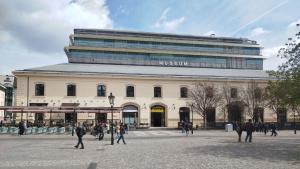
Most industry insiders were eagerly awaiting Q2 sales statistics. Despite the fact that, effectively, the "2% safe loan" program has only been in effect since July 3rd, its impact on quarterly sales performance was significant. For another consecutive quarter, the number of units sold by developers in the six largest markets was about one-third higher compared to the previous three months. Experts at JLL summarised the second quarter of 2023 in the residential market in Poland.
Sales fever - time to start
A total of more than 15,400 new apartments have found their buyers in the country's six largest markets. Unfortunately, as of today, we do not know exactly how many of these apartments have been reserved or bought with the intention of taking a loan with government subsidies. What we do know, however, is that the very fact that the program came into effect caused the remaining buyers to return to the housing market, mobilized by rising prices and shrinking offerings.
"The largest quarterly increase in sales occurred in the Tri-City, where almost 2,500 apartments were sold (+67% q/q). Poznań is also noteworthy, with an almost 50% quarterly increase (1,500 apartments sold). Developers also achieved a similar sales result to Poznań in Łódź. In other markets, quarterly sales growth ranged from 25% in Kraków to 33% in Wroclaw. In Kraków, the sales volume was high enough (3,000 units) to compare with the high average sales of 2016-2019. A total of more than 15,000 units sold means the same volume as in Q3 and Q4 of 2021, when sales were high, but buyer sentiment was already starting to deteriorate with rising interest rates. It is highly likely that the sales peak is yet to come and the next quarter's result could be even better, assuming that interest in the government program remains high and, above all, there are enough apartments on offer",says Aleksandra Gawrońska, Head of Residential Research, JLL
Increasingly shrinking offer
In Q1, developers were very cautious and, rather in anticipation of the new law, explored the possibility of signing contracts with extended payment terms. What distinguishes Q2 is first and foremost the increasing number of advertisements by developers who want to attract buyers who want to take advantage of the "2% safe loan" program, a mortgage with a fixed interest rate of 2 per cent, where any surplus resulting from interest rates is covered by the state. Unlike previous housing programs, this time we don't have a limit on the price of a square meter, but a limit on the amount of one's own contribution and the amount of the loan, which in total determines the maximum price of an apartment. Constructed this way, the program gives buyers much more choice compared to RnS and MdM. At the end of June, in the six largest markets, the share of units meeting the price criteria (with a loan for two) ranged from 59% in Warsaw to as much as 93% in Lodz. Despite good sales and price increases over the three months, the percentage share of residential units available under the cap fell slightly - from 2 to 6 p.p.
The problem in the largest markets, however, is not the share of units under the price cap but the declining total number of available apartments. A total of just over 40,000 units were on offer in the six largest cities at the end of June, which marks another quarterly decline (7% vs. q/q). Still, the offering is higher than in 2021, a time of exceptionally high demand. It should be noted, however, that there were no alarming signs on the supply side at that time. In the following months of 2022, rising interest rates, the increasing cost of investment financing, and the unstable construction material costs caused major problems on the side of newly launched projects. In addition, war-related anxiety and the uncertainty of the market environment caused developers to strongly slow down the start of new construction. Starting in Q3 2022, the number of new housing units launched quarterly in major cities remained below 7,000 units. The past three months have brought some recovery: developers have launched more than 10,000 units, an improvement of as much as 46% compared to Q1 2023. However, the better result does not mean that there are enough new apartments to balance the offer with demand. Parts of the markets are seeing an increasing supply gap and the advantage of the number of sold apartments over new launches has persisted for several quarters.
„Looking at the demand-supply ratio index taking into account the last four sales quarters, we can observe that we still have a state of near equilibrium in the Tri-City, Poznań, and Łódź, but the other three markets have entered a state of demand over supply. However, if we take the sales rate from this quarter only and compare it to the offer, we will find that in all major markets, we are below the supply-demand balance (defined as 4-5 quarters of sales). In Kraków or Warsaw, this means that the offer sell-out rate is as low as 2 quarters i.e. there has been a dynamic return to the situation of 2021 when demand was much higher than the supply”, adds Aleksandra Gawrońska, Head of Residential Research, JLL
The rate of price increase
With the anticipated higher demand and increase in sales, there has been an increase in average apartment prices. In all large markets, the average prices of apartments offered, reached record levels. The Tri-City and Wrocław exceeded the PLN 13,000/sqm mark, and Kraków came close in price to Warsaw, with the average price at the end of June at as much as PLN 14,700/sqm, compared to PLN 15,200/sqm in the capital. Prices in Poznań and Łódź also skyrocketed to PLN 11.5 thousand/sqm and PLN 9.6 thousand/sqm, respectively.
Last year's hopes for price stabilization as a result of weaker sales were dramatically affected by the new government program. Today, customers can no longer count on the promotions and discounts that encouraged them to visit the sales office just six months ago. Today, the incentive is the fear that next quarter could be even more expensive. And on the horizon we see further changes in technical conditions, building with low-energy solutions and other effects of EU ESG directives.



